
This past weekend, my family and I headed to the town of Newcomb in the beautiful Adirondacks. We’ve been to the area before and have enjoyed it, but the purpose of my visit this time was as an invited guest speaker at the symposium “Toward A More Diverse Adirondacks“, where educators, scientists, sociologists, business leaders, and community members addressed the lack of diversity in the community, its effect on the sustainability of the park and the overall well-being and growth of the area.
I came in as a professional in the travel industry and as a frequent speaker on issues of diversity and tourism, to talk about how to best improve perceptions, raise positive awareness of the area among minority travelers, and how to best cater to and attract that community.
It was an interesting role to be in, as I am neither a native nor a resident of the area, whereas a lot of people, if not everyone there, was one or both.
There were many voices represented throughout this all-day discussion, and, as is often the case in conversations on diversity, it was at times very personal and very passionate. It was also exhausting. These discussions took place as my emotions are still reeling from all that is happening in Ferguson – an issue that has been emotionally draining to watch unfold.
But what I wanted to share here was my overall excitement about the fact that this continues to be a conversation happening in not just the urban areas of our country, but also in the rural ones. That community members are becoming aware of their surroundings and are starting to come together for change. A lot of the concerns addressed during the symposium are concerns shared with those I have connected and worked with in the past, like the National Parks Foundation, who in partnership with the American Latino Heritage Fund, worked to try to change perceptions of minorities and the outdoors.
I have spoken on this issue professionally for about 7 years, when I founded an organization in Madison, WI to help expose minority students to college campuses and the view of a better future, a prospect not really offered to minority students in the system they were in. The experience was an important lesson for me on how difficult it is for everyone involved to face the issues and better yet, do something about it.
Everyone, regardless of who they are, or how they identify, wants to feel welcomed and safe where ever they go. When it comes to travel, no one will willingly travel or spend their money in places where they expect to be mistreated in any way or where they will feel like the odd person in town.
During my presentation, which I titled Influence and Opportunities:Diversity in Travel Promotion and Marketing, I talk about the importance of representation in marketing and messaging to draw the attention and interest of a more diverse group of travelers.
For example, if there are attractions and destinations that cater to people with disabilities or any type of physical challenges, it helps to note it. If there is access to information in a different language it’s important to make it available or point it out. If businesses are gay-friendly it can’t and shouldn’t be taken for granted how impactful making a visible statement of it can be. Diversity in marketing and branding is a great way of letting people know they are thought of and welcomed. And yet, it’s an area that is often overlooked and where diversity is underrepresented, if at all. These efforts, especially at first, must be focused and deliberate before they become a natural process.
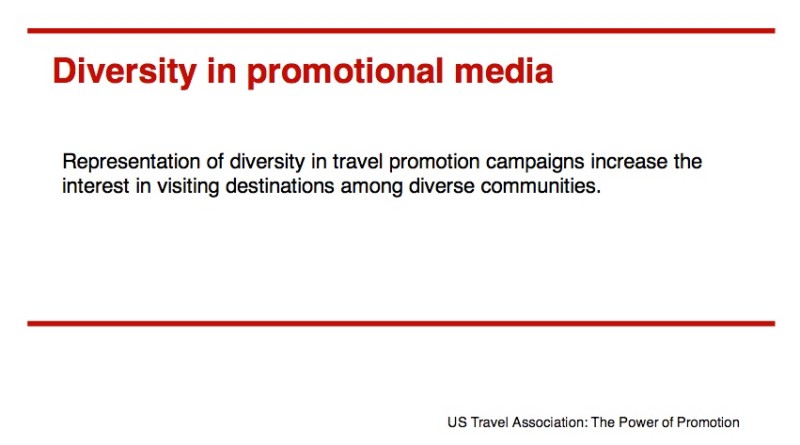
The challenge of course is in representing diversity in a way that is correct and relatable. It’s not enough to just have images that reflect diversity. It’s also important to understand the market you are trying to reach so that they can be served appropriately. Here’s an example of travel trends among Latino and Black communities that serve as an example of things to know if they are a target audience.
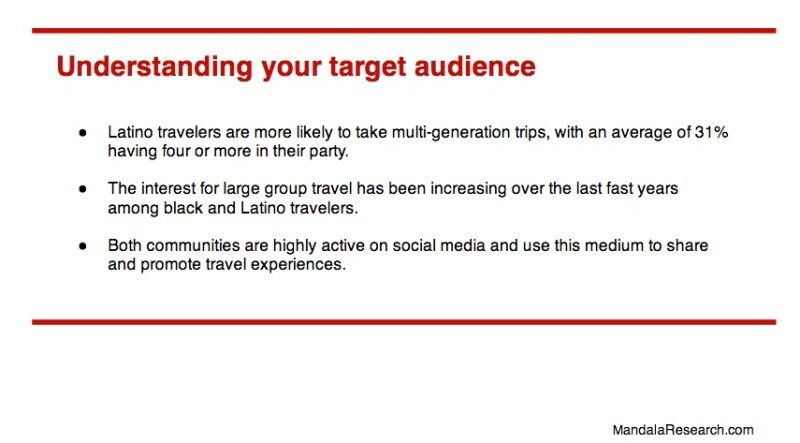
I talked about the changing landscape in our country and shared data gathered by the U.S. Travel Association and others that state that by 2040 the US population will be majority-minorities, with 42% of the country will be Black or Latino and what that means from an economic stand point.
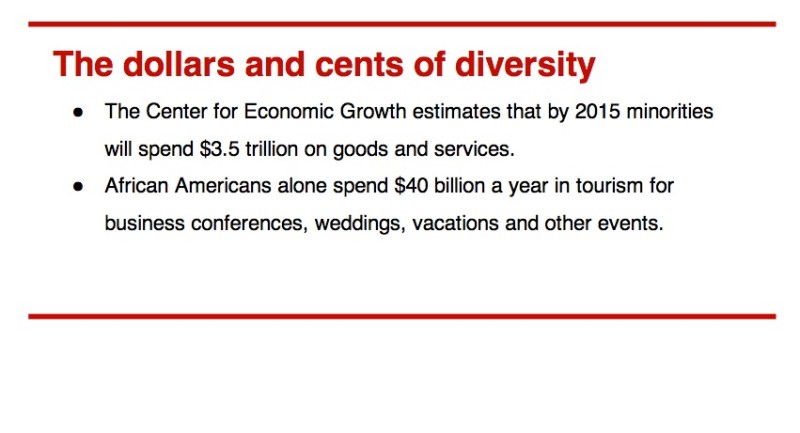 The U.S. Travel Association confirms that travel and tourism is a cash-generating machine for state and local governments. Two years ago, when we were still recovering from a recession, they report that “the travel industry still managed to generate $129 billion in tax revenue to government at all levels and $58.4 billion to state and local governments – enough to pay the wages of every firefighter and police officer in the country”. Their findings have also proven that wise strategic investments in travel promotion by destinations kick off a virtuous cycle of increased traveler visits, greater traveler spending in local communities, faster job creation and higher tax revenues that far surpass the initial investment.
The U.S. Travel Association confirms that travel and tourism is a cash-generating machine for state and local governments. Two years ago, when we were still recovering from a recession, they report that “the travel industry still managed to generate $129 billion in tax revenue to government at all levels and $58.4 billion to state and local governments – enough to pay the wages of every firefighter and police officer in the country”. Their findings have also proven that wise strategic investments in travel promotion by destinations kick off a virtuous cycle of increased traveler visits, greater traveler spending in local communities, faster job creation and higher tax revenues that far surpass the initial investment.
Because targeting minority travelers is still a new concept for many travel brands and professionals, the efforts can’t be left to those who have neither the experience nor the understanding of those communities and groups. This is where recruiting those qualified professionals, who can also speak to and for the communities they represent, becomes a factor. During the symposium many expressed a challenge in finding that diversity during their recruitment efforts, which speaks volumes to the perception of the area among minorities unwilling to move there for work.
Though I don’t believe that tourism is the answer to all the diversity issues, it helps to create exposure to the area and as well as an opportunity to change those perceptions. It helps if travel media brands diversify the voices and faces of travel as well.
I am very proud to work with agencies and brands who want to open that space so that the travel story and experience is shared from a more cultural and personal perspective.
As I stated in my presentation, this isn’t just a feel-good approach, it’s a financially feasible one, as the minority travel community continues to grow into a lucrative travel market.
I highlighted examples like Expedia for how they have incorporated gay-friendly travel destinations and businesses into their product line without much fanfare but with great success.
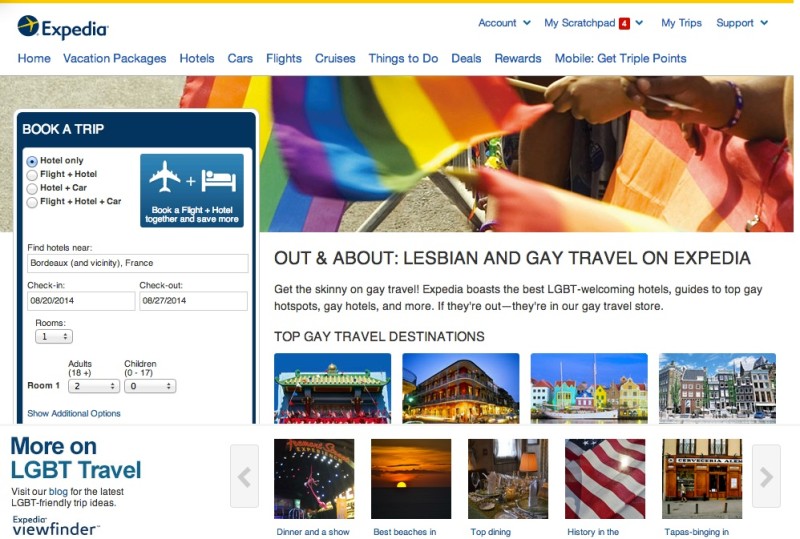
And how I am giving a platform and even encouraged on Expedia Viewfinder to share popular travel destination pieces from a more culturally personal perspective, something rarely ever shared in the world of travel media. These are the kinds of things that peak the interests of multicultural travelers, not only for the destinations, but also in the brands that help to promote them through these unique voices.
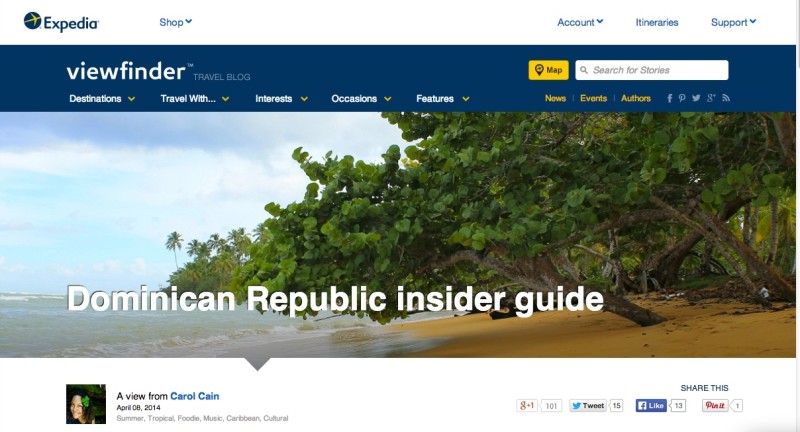
I also left the group with three first steps towards diversifying their messaging, outreach, and audience.

The communities of the Adirondacks have a lot of work ahead of them. It will take time, courage, patience, and yes, even money to make all these things come to fruition. But the dedication of the people in attendance who committed so much of their time to learn, share, grow, and do more for their communities left me incredibly impressed and hopeful for the future of the park.
I want to thank SUNY College of Environmental Science and Forestry, the Adirondack Almanac, and other symposium organizers for their trust and welcome, and for the opportunity to share my experiences and my voice on this issue.
[subscribe2]

